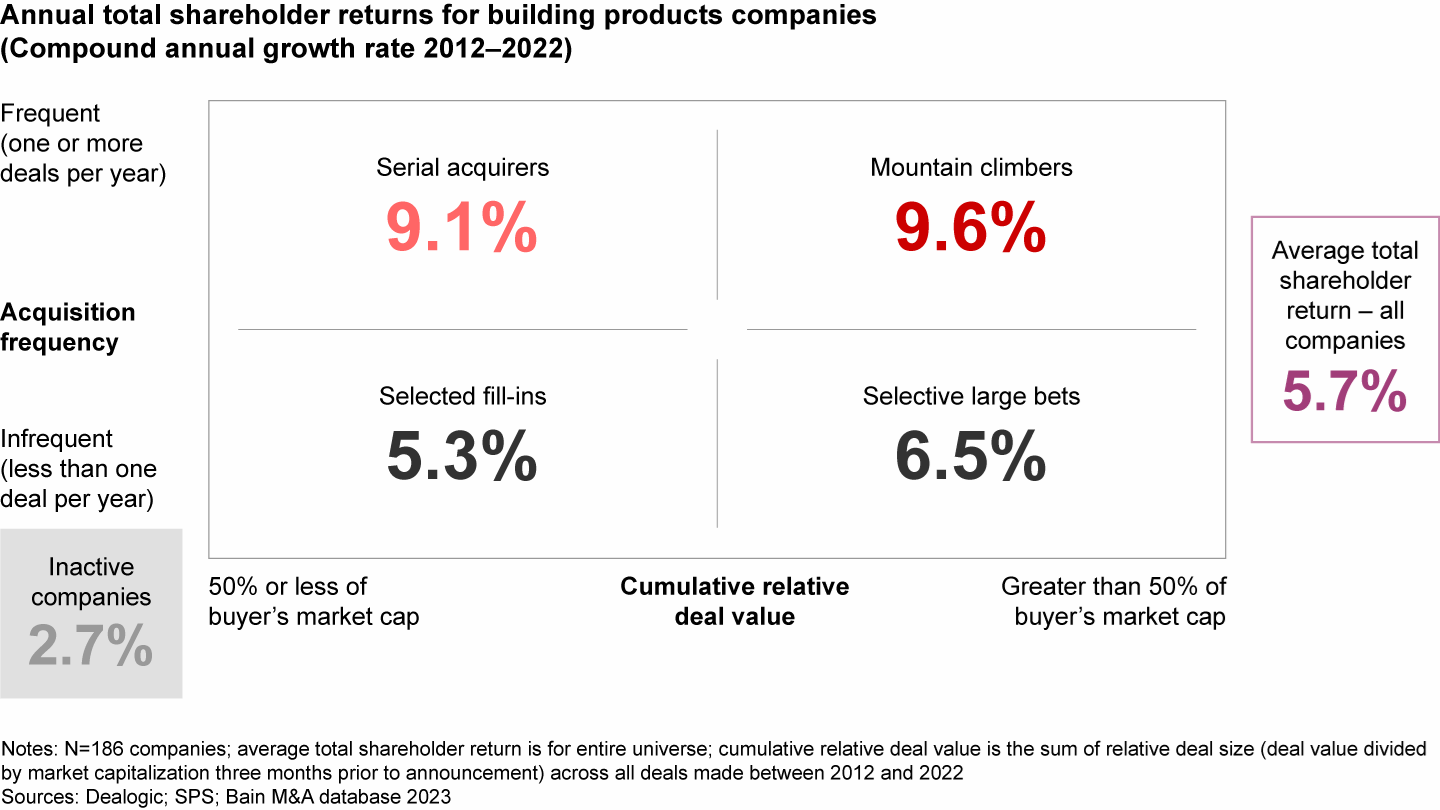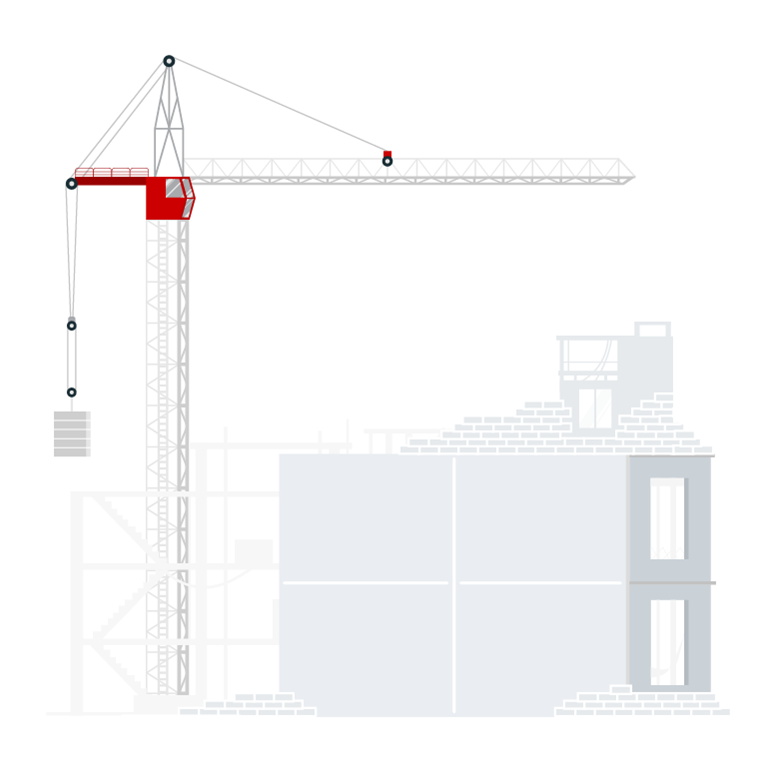M&A Report

At a Glance
- Building products companies that make frequent and material acquisitions substantially outpace inactive companies in total shareholder returns, 9.6% vs. 2.7%.
- In many product segments and geographies, consolidation limits opportunities for traditional scale deals in the local core.
- The most successful companies will pursue scope M&A to build product, geography, and capability adjacencies that deliver a path to leadership and accelerate growth.
- A common misstep is misunderstanding an acquirer’s parenting advantage.
This article is part of Bain's 2024 M&A Report.
It seems like the perfect time to pursue M&A in building products. Many players are rich in cash, with low levels of debt and high access to the capital needed for deals. There are ample one-off opportunities to acquire struggling assets. Financial investors have taken a step back, especially in North America, removing a potentially formidable layer of competition. And the industry is feeling a lot of anxiety amid the macroeconomic uncertainty—just the type of environment that has proved to offer opportunities to companies that are willing to make bold moves.
If that’s not enough evidence, here’s something else. Our long-term research on M&A’s contribution to shareholder gains shows how building products companies that make frequent and large acquisitions substantially outperform. They achieve total shareholder returns of 9.6% compared with 2.7% for their inactive counterparts (see Figure 1).
Building products companies that make frequent and material acquisitions deliver higher shareholder returns long term


Yet despite the favorable conditions and the outsized success record, today’s deal prospects are less than perfect, and the reality is that the companies that emerge as M&A champions in building products in 2024 and beyond will be those that outdo competitors by making adjacency moves as part of a clearly defined M&A strategy—and that do so with rigorous preparation.
Building products is a local business, with success highly dependent on local relative market share. Within individual product groups, the industry is highly consolidated. So, within those many subsegments, there are just too few companies to make local scale deals—the deals with the most common path to profitable growth—even feasible. As a result, pursuing growth (beyond the rate of GDP) typically requires companies to turn to scope M&A, buying adjacencies that take them to unfamiliar businesses outside of their core. In these deals, companies acquire for access to new product categories, new geographic markets for existing products, or new capabilities—everything from technology or software solutions to modular construction or environmental, social, and corporate governance solutions.

Constructing an M&A Strategy in Building Products
Most building product companies play in mature markets, with low long-term growth. M&A can help them achieve growth ambitions.
In building products, scope M&A typically can’t match the high rate of success achieved with scale deals. There are multiple reasons why it takes more work to identify and realize synergies outside of the core. For example, acquirers in scope deals often overlook the fact that there’s little opportunity for customer sharing. The varying decision-making processes across distributors, contractors, and specifiers for each product limit the relevance of existing relationships and brands. Similarly, there’s often little opportunity for cost sharing as products outside the core often require a separate manufacturing footprint and expertise, with different raw materials and logistics needs.
Here’s how building products companies can use M&A to boost profitable growth.
Prioritize your core to build local positions of strength. Yes, there may be few opportunities to acquire for scale cost synergies, but when opportunities arise in the core—be they through small tuck-ins or large-scale deals—they are the surest bet for operational synergies and strong returns on investment (ROIs). Builders FirstSource, for example, bolstered its core through several tuck-in acquisitions across the US in 2023.
Buy into adjacencies that give you a path to leadership. Entering a new space requires a company to build upon its parenting advantage, and that starts by being clear about what that parenting advantage is. A company may have good logistics muscles in its current capacity, for example, but it needs to be strong enough in that capability to transfer to other companies. Can you truly add more value than any other owner? Is the parenting advantage repeatable? This is one area in which we’ve seen too many companies enter deals with too much confidence. The result: Instead of advancing to leadership and realizing their deal theses, they remain subscale and have poor ROIs. Once you are aware of your parenting advantage, continuously invest and strengthen it to ensure a lasting advantage over time and generate real value in a succession of acquisitions.
The path to leadership also generally means overlooking smaller assets in favor of bigger players for a first move in a new space. Consider the big play made by Holcim in US commercial roofing with its 2021 purchase of Firestone Building Products, one of the largest commercial roofing players. Holcim then built on that new core by acquiring Duro-Last Roofing Systems in 2023. It’s much easier to add smaller businesses to a large initial entry point than to build up a new core from a “string of pearls” approach of small plays that are difficult to fully integrate.
Other adjacency paths include acquiring capabilities such as building information modeling and robotics, off-site manufacturing, or advancing from traditional distribution to digital commerce. Given the relatively high fixed costs in some of these areas, there is more potential to benefit from cross-regional scale than there is in traditional building products. Hilti, for example, in 2021 acquired Fieldwire, a platform for jobsite management, to accelerate its ability to deliver productivity to its customers across more than a million jobsites worldwide.
In Europe, sustainability will spur the next wave of M&A, with players buying into cleaner categories, such as wood, or acquiring emerging capabilities that will underpin a low-carbon future. NIBE, for example, agreed to acquire Dutch Group Climate for life in 2023 to become one of the larger climate solutions providers in Europe.
Divest nonstrategic assets to free up capital to invest in more strategic ones closer to the core. Trade up by divesting businesses that don’t give you a clear path to leadership and investing in those that do. Allowing management to focus on a more related group of products with some level of shared channels, end markets, or manufacturing processes helps focus efforts and tells a clearer equity story. Carlisle, for example, pivots to a pure play building products company. Recent M&A moves underpin this agenda. In 2021, Carlisle acquired Henry Company, a provider of building envelope systems, while divesting its non–building products division Fluid Technologies in 2023 and beginning the process to sell Interconnect Technologies.
Invest to continually improve M&A capabilities. Winners will be better and faster in their diligence abilities to identify, integrate, and unlock the full potential of deals. That means adapting these processes to changing times. For example, many building products companies saw expanded margins in recent years as post-pandemic supply shocks and high demand rippled through the construction market. Now, with inflation dropping in many categories, acquiring companies need to ensure that they understand the new importance of factoring pricing dynamics in diligence. Is the target company equipped to maintain margins—and to what extent? The answer could reveal one critical indicator of the asset’s potential to create value, or it could signal to the acquirer that it’s time to walk away from the deal.